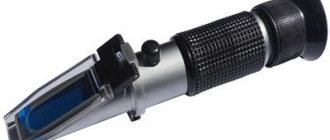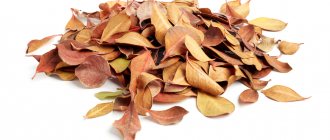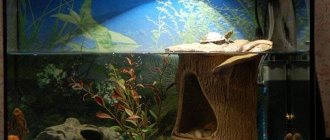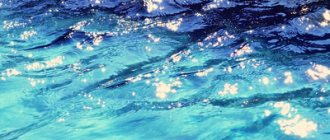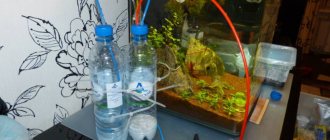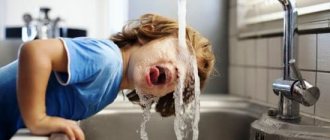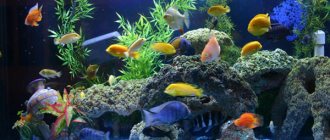Is it possible to put bottled water into an aquarium and use it there as a habitat for various species of fish or freshwater amphibians? Compared to liquid from the tap system, this option definitely looks much more attractive in terms of composition. But even here there are limitations that must be taken into account. For example, water purified by reverse osmosis is unsuitable for aquarium keeping and can lead to a deterioration in the living conditions of waterfowl. It is extremely important to ensure that the mineral composition remains unchanged. Bottled water for an aquarium is the optimal solution only from the point of view that it has constant mineralization indicators, since it comes from a single source. Experiments are unnecessary here; it is much better, from the point of view of the comfort of aquatic inhabitants, to find one specific brand of product and use it.
Is it permissible?
Using bottled water in an artificial pond is a great way to maintain high H2O quality because:
- it is free of toxic compounds such as chlorine and heavy metals,
- always has good transparency.
Reference! Aquarists use both regular purchased water and carbonated water, but for completely different purposes.
Regular from the store
Ordinary water is used by lovers of artificial reservoirs on an ongoing basis . With its help, aquarists start up aquariums, make weekly changes and top up to replace what has evaporated.
It does not contain dissolved gases and, as a rule, has a slightly acidic reaction, which is optimal conditions for most aquarium fish.
Carbonated
Using soda is an old fashioned way of feeding aquarium plants with carbon. After all, water is carbonated due to carbon dioxide, which accelerates plant growth.
Therefore, many hobbyists add soda at the rate of 10 ml per 10 liters of aquarium water daily along with fertilizers before turning on the lights.
Important! The gas is absorbed by plants and dissolves, but hardness salts remain. Therefore, if you use soda as an alternative to CO2, you should regularly check the hardness of the aquarium water and, if necessary, add osmosis or distilled water.
What kind of water should I put in the aquarium?
Water is available to humans from various sources. There are many options, so it is important to know what is suitable for aquatic life. This is especially of concern to aquarists who are setting up a pond for the first time. Before pouring water into the aquarium, you need to make sure that it is safe and beneficial for aquatic flora and fauna.
Plain tap water
Tap water is the most affordable option, containing all the microorganisms necessary for the development of fish. To better use its qualities, the liquid is tested before use.
In different regions and settlements, water differs greatly in its composition. The huge disadvantage is that for the most part it is very tough. This indicator may become an obstacle to the use of such liquid. Pathogens can also get into tap water.
Tap water can be poured into the aquarium only after it has been left for at least 1-2 days in an open tank. This is done so that the chlorine disappears and mechanical impurities settle to the bottom.
Boiled
Water after heat treatment does not contain dangerous microbes and bacteria. But there are a lot of disadvantages:
- does not contain useful microelements that fish need to develop immunity;
- in boiled water there is a reduced hardness index.
It is impossible to boil a large volume of water in huge tanks. When asked whether it is possible to pour boiled water into an aquarium, experienced aquarists answer this way: it is applicable only for those inhabitants who are accustomed to it from birth.
Filtered
When water passes through the filter, it is considered “dead”. It does not contain beneficial microorganisms, but it also does not contain heavy metals, salts and other dangerous impurities. Before pouring water into the aquarium that has passed through the filter, it must be settled so that volatile chlorine compounds disappear.
Not all types of filters can be used. Water passed through the following filters cannot be poured into the aquarium:
- with antibacterial effect;
- remineralizer;
- saturating with silver ions.
Liquid that has been purified using such equipment can be harmful to aquatic life. Such an aquatic environment will be radically different from the natural one.
Bottled
Commercial bottled water does not contain chlorine. There is no need to defend it. But choosing a liquid with the right level of hardness is difficult. Good bottled water is an expensive option for fish. In the aquarium industry, cases have been described when shellfish died after pouring bottled water. This suggests that not all bottled water is of high quality.
On a note! If ordinary tap water is of very poor quality, you have to choose between bottled or filtered water, the second option is better.
Distilled
There are no salts or harmful compounds in the liquid that has undergone the distillation procedure. It is completely cleaned. You can’t take it entirely for an aquarium, but you can add it partially to the tap water.
From a river, lake, well
Well, river and lake water may contain dangerous chemical compounds in doses that are fatal to fish. These include phosphate compounds, nitrates and other similar elements. Such water can only be used if you are completely sure that it is harmless.
Rainy
Rainwater has a similar composition to distilled water. Complete absence of beneficial bacteria and microelements. This liquid is used only to reduce the level of hardness. Please note that rainwater may contain harmful acids. Therefore, it should be used only after tests and in small quantities.
Which one is allowed?
Not every commercial water is suitable for use in aquariums.
You can find various types on
- mineral,
- artesian
- drinking water.
It is ordinary drinking water that can be used.
As for mineral water, it contains an increased amount of salts, which negatively affects the development of plants and most fish. Artesian water has high acidity, which is also unacceptable for many aquatic organisms.
Most aquarium fish and plants prefer soft and slightly acidic water. And bottled water, which is sold as regular drinking water, is most often nothing more than osmotic water.
Interesting! The attitude of entrepreneurs who bottle osmotic water is not entirely fair. But in this case, it is to the benefit of aquarists, since this water satisfies all their needs.
Pros and cons of using such water
Advantages:
- Optimal parameters for fish.
- Minimal risks of poisoning of aquatic organisms caused by poor water quality.
- Plants grow much better in soft water because they can more easily absorb nutrients.
- The manufacturer always indicates the approximate chemical composition on the label; this is important for aquarists; it allows for a more thoughtful distribution of fertilizer application.
- Soft has a weak buffer, making it easier to regulate acidity.
Flaws:
- Some manufacturers, in order to prevent water from blooming in case of long-term storage, add antibiotics. Once in the aquarium, the antibiotic kills beneficial bacteria, thereby disturbing the balance in the system.
- Price. If the aquarium is 30 liters, then a daily change will require about 10 liters of bottled water, and this is tolerable. And replacements in large aquariums require from 50 liters weekly, which noticeably hits many aquarists in the wallet.
Checking H2O parameters
Before using aquarium water, it should be tested. The main parameters that interest any aquarist are:
Carbonate hardness (KH) . This indicator is the most important. The lower it is, the better. Water with a KN greater than 6 should not be used.- General hardness (GH). For most cases, this is not the most important parameter, but if the aquarist is interested in ornamental shrimp or finicky plant species, then he carefully monitors the overall hardness of the water. The lower it is, the better. The lack of salts can always be restored artificially.
- Nitrates and phosphates (NO3 and PO4). As a rule, in bottled water the values of these parameters are minimal, but still, it is worth making sure.
Reference! There is another way to quickly check bottled water - using a TDS meter. This device shows the ratio of substances dissolved in it. And if the device shows a value of up to 30, then you don’t even need to test the water further.
How to prepare water for an aquarium
In order for the fish to frolic and the plants to increase their vegetative mass, it is necessary to create conditions close to natural ones. To prepare a liquid suitable for aquatic life means to remove heavy metals, mechanical impurities, phosphates, chlorine and nitrogen compounds from it. Any aquarist can do this at home. The following methods are used:
- Use conditioners according to instructions. The drugs can be purchased in specialized stores. Their use is advantageous in that there is no need to waste time settling the water.
- Add the substance sodium thiosulfate (10 g of substance per 100 l of water). With its help, the bonds between chlorine and ammonia are eliminated. For mixing, turn on the aerator for 2 hours.
- Reduce the hardness of tap water by adding distilled liquid. For the same purpose, you can partially boil it.
- The modern way is to pass the liquid through an osmotic filter or ionizer.
Preparing water for an aquarium is an important process that cannot be ignored when arranging a home pond.
How to bring hardness and acidity parameters back to normal?
If the water parameters do not correspond to the optimal ones, they can be adjusted.
Carbonate hardness
It’s very easy to increase the KN, just add a little regular baking soda, but lowering it is much more difficult. The easiest way is to change bottled water to another.
But if you urgently need to use it, and there is a need to reduce carbonate hardness, then there are several options, but they are quite labor-intensive:
- Boiling. The water is boiled and the top 80% is drained, what remains at the bottom is poured out. This procedure can be performed several times.
- Freezing. It is frozen, then the bottom piece of ice is broken off, thrown away, and the top one is left.
- Ion exchange resins are used.
All these methods are not worth doing. It is much easier to choose the water that initially suits the parameters.
Overall hardness
When checking water parameters, you may encounter such indicators as: KH=0, GH=0. These are great settings, but the water requires some minor adjustments.
It is necessary to increase the overall hardness to at least 4. This can be done using special mineralizers that guarantee the correct ratio of calcium and magnesium salts.
Acidity
The acidity of water pH is an unstable indicator. Its ability to decrease directly depends on the KN. The higher the carbonate hardness, the stronger the buffer and the more difficult it is to lower the pH.
Aquarists reduce acidity by supplying carbon dioxide, but if KH is above 8, then in order to lower the pH to the required level, so much gas will have to be pumped in that not a single fish can withstand it. That's why it's so important to use soft water.
Attention! Do not lower the pH using phosphoric acid. The acidity will decrease only temporarily, but the phosphates will remain for a long time, creating problems with algae.
You can also lower the pH using alder cones or ketapang leaves, but their effect is negligible. 1 cone per 10 liters can reduce pH by 0.5 units.
Basic water parameters
Water parameters depend on the types of aquarium fish. The water in an aquarium has three main indicators:
- pH is an acid-base indicator. Most fish prefer neutral water. You can check the pH using indicators that are purchased at pet stores. The parameters are adjusted using ordinary soda or peat, which is placed in the filter. Soda raises the level, peat lowers it.
- GH is water hardness. Some fish like hard water, others softer. It is important to remember that GH equal to zero will kill the inhabitants. Natural calcium is used to increase hardness: shells, limestone, marble. To reduce it, water is boiled or frozen. The last method is troublesome, but effective. You can use a chemical method: add calcium chloride or magnesium to the water. Some plants also regulate GH levels. But here it is necessary to take into account the interests of the fish.
- Temperature. This indicator is selected taking into account the species of fish. The water temperature must be monitored daily, avoiding overheating or hypothermia. You don’t have to worry about it and buy heat-loving fish so you don’t have to worry about their condition in the summer heat. For cold-loving people, you will have to purchase special equipment for heating water. Fish are very sensitive to sudden fluctuations. They experience real stress from temperature fluctuations.
Compliance and careful verification of these indicators will ensure the creation of the correct aquarium.
How to add?
It is best to use bottled water for an aquarium with weekly changes.
The volume of substitutions depends on the type:
- A medium-populated aquarium or herbal aquarium – 30% water weekly.
- densely populated aquarium with large fish - either once a week 50%, or 2 times 30%.
- Shrimp - once a week 10-15%.
After purchasing water, be sure to wait until it warms to room temperature before adding it to the aquarium. This is especially important in winter.
Reference! A sharp decrease in the temperature of aquarium water provokes many infectious diseases in fish and unplanned molting of shrimp.
First fill
Having decided what kind of water can be poured into the aquarium, you should know the rules for first pouring liquid into the tank:
- The aquarium is washed with plain water, the glass is wiped using soft sponges or rags.
- Place pre-treated soil on the bottom.
- Tap water is added to the tank and left to settle. Over time, the water will become cloudy due to bacterial growth.
- When the aqueous medium becomes transparent again, check the parameters of the liquid. If the indicators are normal, vegetation is planted and fish are stocked.

